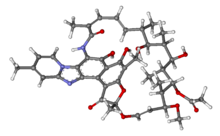Rifaksimin
Rifaksimin je organsko jedinjenje, koje sadrži 43 atoma ugljenika i ima molekulsku masu od 785,879 Da.[1][2][3][4][5]
 | |
 | |
| Klinički podaci | |
|---|---|
| Prodajno ime | Fatroximin, Normix, Rifacol, Ritacol |
| Drugs.com | Monografija |
| Način primene | Oralno |
| Farmakokinetički podaci | |
| Poluvreme eliminacije | 6 h |
| Identifikatori | |
| CAS broj | 80621-81-4 |
| ATC kod | A07AA11 (WHO), D06AX11 |
| PubChem | CID 6436173 |
| DrugBank | DB01220 |
| ChemSpider | 4940837 |
| ChEMBL | CHEMBL1617 |
| Hemijski podaci | |
| Formula | C43H51N3O11 |
| Molarna masa | 785,879 |
| |
| |
Osobine
уреди| Osobina | Vrednost |
|---|---|
| Broj akceptora vodonika | 12 |
| Broj donora vodonika | 5 |
| Broj rotacionih veza | 3 |
| Particioni koeficijent[6] (ALogP) | 4,8 |
| Rastvorljivost[7] (logS, log(mol/L)) | -8,2 |
| Polarna površina[8] (PSA, Å2) | 198,4 |
Reference
уреди- ^ Cottreau, Jessica; Baker, Shannon F.; Dupont, Herbert L.; Garey, Kevin W. (јул 2010). „Rifaximin: A nonsystemic rifamycin antibiotic for gastrointestinal infections”. Expert Rev Anti Infect Ther. 8 (7): 747—60. PMID 20586560. doi:10.1586/eri.10.58.
- ^ Williams, R.; Bass, N. (2005). „Rifaximin, a nonabsorbed oral antibiotic, in the treatment of hepatic encephalopathy: Antimicrobial activity, efficacy, and safety”. Rev Gastroenterol Disord. 5 (1): S10—8. PMID 15976747.
- ^ Koo, Hoonmo L.; Dupont, Herbert L. (јануар 2010). „Rifaximin: A unique gastrointestinal-selective antibiotic for enteric diseases”. Curr Opin Gastroenterol. 26 (1): 17—25. PMC 4737517 . PMID 19881343. doi:10.1097/MOG.0b013e328333dc8d.
- ^ Knox, C.; Law, V.; Jewison, T.; Liu, P.; Ly, S.; Frolkis, A.; Pon, A.; Banco, K.; Mak, C.; Neveu, V.; Djoumbou, Y.; Eisner, R.; Guo, A. C.; Wishart, D. S. (2011). „DrugBank 3.0: A comprehensive resource for 'omics' research on drugs”. Nucleic Acids Research. 39 (Database issue): D1035—41. PMC 3013709 . PMID 21059682. doi:10.1093/nar/gkq1126.
- ^ Wishart, D. S.; Knox, C.; Guo, A. C.; Cheng, D.; Shrivastava, S.; Tzur, D.; Gautam, B.; Hassanali, M. (2008). „DrugBank: A knowledgebase for drugs, drug actions and drug targets”. Nucleic Acids Research. 36 (Database issue): D901—6. PMC 2238889 . PMID 18048412. doi:10.1093/nar/gkm958.
- ^ Ghose, Arup K.; Viswanadhan, Vellarkad N.; Wendoloski, John J. (1998). „Prediction of Hydrophobic (Lipophilic) Properties of Small Organic Molecules Using Fragmental Methods: An Analysis of ALOGP and CLOGP Methods”. The Journal of Physical Chemistry A. 102 (21): 3762—3772. doi:10.1021/jp980230o.
- ^ Tetko, I. V.; Tanchuk, V. Y.; Kasheva, T. N.; Villa, A. E. (2001). „Estimation of aqueous solubility of chemical compounds using E-state indices”. Journal of Chemical Information and Computer Sciences. 41 (6): 1488—1493. PMID 11749573. doi:10.1021/ci000392t.
- ^ Ertl, P.; Rohde, B.; Selzer, P. (2000). „Fast calculation of molecular polar surface area as a sum of fragment-based contributions and its application to the prediction of drug transport properties”. Journal of Medicinal Chemistry. 43 (20): 3714—3717. PMID 11020286. doi:10.1021/jm000942e.
Literatura
уреди- Hardman JG, Limbird LE, Gilman AG (2001). Goodman & Gilman's The Pharmacological Basis of Therapeutics (10. изд.). New York: McGraw-Hill. ISBN 0071354697. doi:10.1036/0071422803.
- Thomas L. Lemke; David A. Williams, ур. (2007). Foye's Principles of Medicinal Chemistry (6. изд.). Baltimore: Lippincott Willams & Wilkins. ISBN 0781768799.
Spoljašnje veze
уреди
| Molimo Vas, obratite pažnju na važno upozorenje u vezi sa temama iz oblasti medicine (zdravlja). |